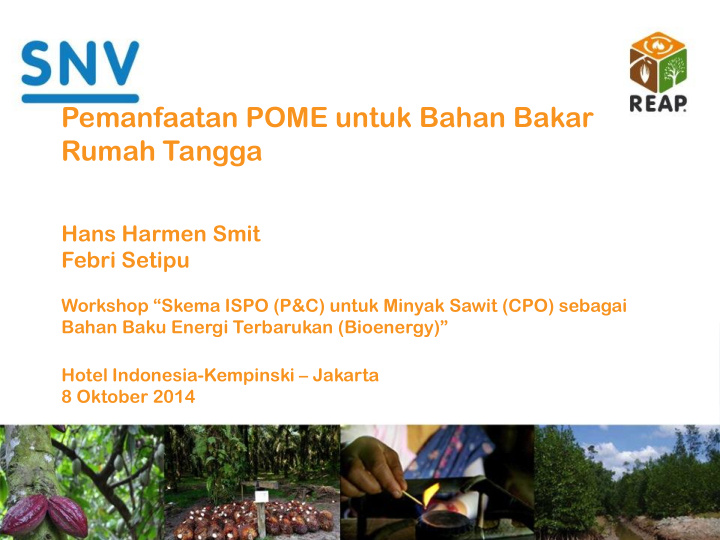



Pemanfaatan POME untuk Bahan Bakar Rumah Tangga Hans Harmen Smit Febri Setipu Workshop “ Skema ISPO (P&C) untuk Minyak Sawit (CPO) sebagai Bahan Baku Energi Terbarukan (Bioenergy)” Hotel Indonesia-Kempinski – Jakarta 8 Oktober 2014
Introduction SNV REAP • Livelihood benefits needs to be a more central objective; no regrets integrate non carbon benefits • Understand and address drivers of deforestation and forest degradation • Build on current forest and land use policies and plans process • Taking a landscape approach; explore trade offs across sectors • Integrate with Agriculture and RE teams 2
• Challenge: how do we balance the increasing demand for agricultural products (food demand by 70% by 2050) and local biomass energy needs whilst improving the livelihoods of local communities, in a manner that does not continue the extensive clearing and/or degradation of forests 3
• Developing knowledge products REAP to advance understanding on Key components interface between agriculture and energy use across forest landscapes [2013/14] • Testing a no regrets practical approach in pilot sites which lead to improved livelihoods, forest protection and reduced emissions • Strategic partnerships with companies, bodies, governments to replicate impacts • Training staff and local partners 4
Implement Approach • Work at three levels: landscape, businesses and farmers/ community • Testing across pilot landscapes ( Vietnam, Indonesia, Ghana, DRC, +) • Focal commodities: Palm oil, Coffee, Cocoa, Shrimp, Woodfuel and [livestock, rice] • SNV has developed various knowledge products to help shape interventions 5
SNV and Renewable Energy • SNV has more than 20 years of experience on Biogas, Improve Cook Stoves, Solar and other renewable energy technologies • SNV works on renewable energy in 17 countries of Asia and Africa • SNV’s main strategy is to strengthen private sector through capacity building and develop sustainable market based renewable energy sector 6
SNV Biogas Coverage in Asia Nepal Bhutan Bangladesh Laos Cambodia Vietnam 2011 2006 2007 2006 2003 1992 Pakistan 1,961 317,135 35,132 2,888 21,209 179,033 2009 4,838 Indonesia 2009 12,414 Total production: (By the end of June 2014,) Asia: 574,610 digesters Asia, Africa and Latin America; 622,007 digesters Operation rate: approx. 90% 7
Implementation model Operasi dan Pemeliharaan Perpanjangan Promosi Pelatihan Penjualan Dan Layanan Litbang Layanan Keuangan Setelah Monitoring Q-Control Penjualan Dan Evaluasi Coordinasi/implementasi Coordinasi/ level kebijakan 8
Context 14 million cattle - 2 million digester technically • potential 30 thousands cattle farms and poultry farms- market • for 30,000 medium and large size digesters Large amount of seaweeds waste available in costal • areas (3 million tones/ year) Significant number of tofu home industries – potential • for biogas from tofu waste (48,000 home industries) Large amount of palm oil mill affluent available • 9
SNV’s Renewable Energy in Indonesia Started Domestic Biogas Programme together with • Hivos in 2009 (BIRU) supported by Ministry of Energy More than 12,000 high quality digesters are • constructed in 9 provinces 98% digesters are well functioning • Total 800 local masons are trained • About 50 local partners strengthened and involved • All appliances are newly designed & locally • produced Project is registered under Carbon Financing • Mechanism Communal biogas digesters were installed in • Central Kalimantan One pilot digester installed in Muaro Jambi utilizing • POME 10
Domestic Biogas Digesters (With Hivos) • Gas for cooking & lighting • Savings fuels & time • Smokeless kitchen • High quality fertilizer • Constructed by local masons • More than 20 years life time 11
Medium Scale Biogas Digesters • Cooking, lighting and electricity generation • Mainly at large cattle farm • Higher than 30m3 size 12
Pilot Digester Utilizing POME • One digester of 50m3 is installed at Desa Marga Mulya unit 2 Kecamatan Sungai Bahar, Kabupaten Muaro Jambi • 10 local masons are trained on biogas construction • Design of digester is very strong, reliable and works more than 20 years • 15 houses are connected through pipeline and gas is supplied for cooking • The approach of SNV is - sustainability, market based, sense of ownership, long term functioning, durable design and maximization of benefits 13
Digester Construction 14
Results • Gas production is sufficient • Every house use gas for 5 hours every day • The optimum gas pressure is 80 Cm that indicates an appropriate design of the digester for POME • Bio slurry is discharged every day which will be used as fertilizer • Use of gas has reduced consumption of fuel wood, LPG and charcoal • Users are very happy with the access of gas 15
Next Steps • SNV aims to scale up this success in Jambi and other potential areas joining hands with Government, donors, local organizations and local communities • SNV aims to install digesters up to 200 m3 with the aim of producing electricity • Digester will be integrated with agriculture, environment and income generating activities 16
Thank you for your attention 17
Recommend
More recommend